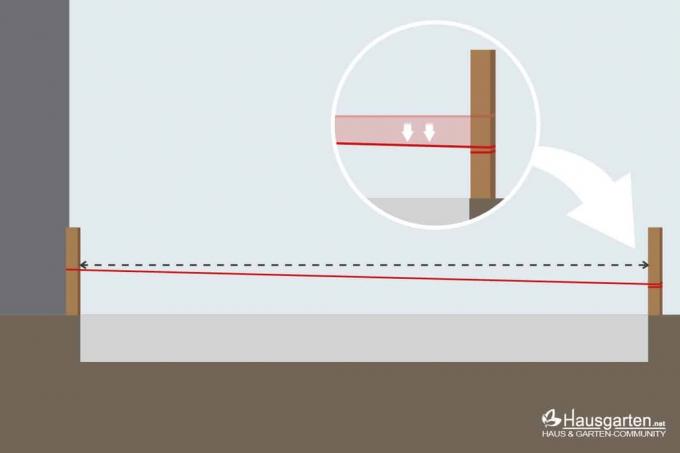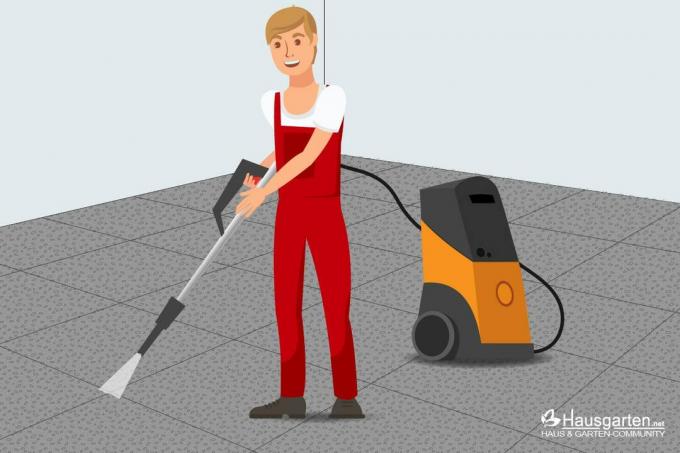

Table of contents
- Brief description of lichens
- methods
- Mechanically
- chemical
- home remedies
- thermal
- frequently asked Questions
A covering of lichen on paving stones not only looks ugly, but also poses the risk of slipping. With the following tips, you can easily and effectively remove unloved roommates from your patio and garden paths.
Brief description of lichens
Lichens are symbiotic communities consisting of a fungus and one or more types of algae with the following distribution of tasks:
- Mushroom: Protection against harmful environmental conditions and for the absorption of substances from the environment
- alga: formation of nutrients

Probably the greatest weakness of lichens is the lack of roots, which is why they have to absorb the required substances directly from the environment. This circumstance makes lichens susceptible to toxic substances in their environment.
Tip:
When dehydrated, the upper and lower outer surfaces of the lichen harden to protect the algae. In this state, it is even more difficult to remove.
methods
Have already lichen formed, you should remove them as early as possible. Depending on the degree of propagation and the subsoil, different methods are useful.
Mechanically
If the lichen is limited to a small area, it is sufficient to remove it from the substrate with plenty of water and the following tools:
- a wire brush
- a mop
- a spatula
- a high-pressure cleaner

Since no other substances are required, this method is the most environmentally friendly. However, the effort required can be very high, which is why mechanical removal of lichen is not suitable for large areas or for sensitive or soft surfaces.
chemical
The trade offers a variety of chemical lichen removers. These usually work very reliably and prevent a recurrence for a certain period of time, as they also kill the fungal spores.
The strength of the agent and its environmental compatibility can be estimated using the following warnings:
- "Harmful to the Environment"
- "Corrosive"
- "Caution"
Since lichens are very resistant, these substances are usually very aggressive and also have an extremely negative effect on other plants. They are therefore hardly suitable for use in gardens with groundwater access.
home remedies
A tried and tested remedy is Vinegar. Putting fruit or wine vinegar directly on the lichen and letting it sit will kill the fungus. The lichen can then be separated from the stone with plenty of water and a hard broom or wire brush.
The effort required here is significantly less than with purely mechanical removal.
Tip:
Vinegar can only be used as a fungicide or bactericide. In closed areas and near other plants, e.g. B. Weeds in joints, this method is forbidden and therefore legally questionable.

soda or baking soda are similar to vinegar in use and effect. Dissolve 20 to 30 grams of the powder in boiling water. Spread the solution warm on the affected area and leave it on. The lichen can then be removed with plenty of water and a hard broom or wire brush.
Repeat the application after a day or two. This will prevent remnants of the lichen from remaining and spreading again.
thermal
With a weed burner you can kill lichens almost completely. The heat first removes the water from the organism, then the organic components burn. However, since the outer layer of the lichen hardens when dehydrated to protect the inner algae from water loss, this process takes some time. Therefore, you have to work the affected areas with the burner for a relatively long time, which can leave unsightly soot stains on the pavement.
Tip:
Harmful gases may be produced when burning. Therefore, cover your mouth and nose when doing this work and make sure that there are no children or animals nearby.
This method is particularly useful for large areas of lichen infestation, e.g. B. in a newly taken over garden, suitable. Allow the torch to "wander" slowly and evenly across the surface several times. This will prevent overheating and damage to the pavers.

A notice:
To permanently remove lichen, you must also kill the spores of the fungus. However, since lichens grow very slowly, the above methods work for at least one or two gardening seasons. Newly forming lichens are very easy to remove mechanically.
frequently asked Questions
Lichens absorb the required substances directly from the air or form them through photosynthesis of the algae. Locations in a nutrient-rich, clean environment with plenty of sunlight and regular water supply are therefore ideal.
Basically, lichens are not harmful to humans, animals, plants or objects. However, some types contain fragrances or dyes that can trigger allergic reactions in the case of hypersensitivity.
If a lichen spreads too much on a plant, it can affect bud formation. Some lichens are very firmly attached to the substrate and can cause minor damage over a long period of time.
It is not always easy to tell whether the paving stones are covered with moss or lichen. The two can best be distinguished by colour, structure and location. Moss is green, soft and grows in damp, shady places. Lichens can have different colors, are harder than moss and grow well in sunny and dry places. However, this does not matter when removing the covering, since the methods also work against moss.
The fungus of a lichen cannot survive without the algae part. Fungal spores spread through the air and are therefore unavoidable. However, avoiding algae in the garden also reduces the risk of lichen formation. Ponds, pools and streams should therefore be cleaned thoroughly in the spring before you fill them with fresh water. In very hot summers, regular treatment with algae remover makes sense. This also prevents the pond from tipping over and smelling unpleasant.
 Mandy
Mandy
Learn more about building a terrace

Distance between decking boards | Information on terrace construction
A correct distance between the terrace boards and the substructure determines the longevity of a terrace. Only well-ventilated wood dries out optimally to prevent the formation of mold and rot. Last but not least, the movement tolerance plays another decisive role.

Lichen: remove white spots on paving stones
In addition to mosses, yellow-white coverings often adorn the paving stones of our driveways. It is not uncommon for dull stains to spoil the joy of the new stones shortly after they have been laid. Although sometimes wrongly dismissed as an indication of poor material quality, this is actually a natural phenomenon.

Determine the gradient on a terrace: this is how it works
Rain, snow or ice, depending on the weather, water collects on the patio floor. The terrace needs a slope so that no annoying puddles form on it. Calculating the slope is easy once you know the length and material of the decking.

Terrace construction: the 1×1 of the substructure
When constructing a terrace, the substructure plays a decisive role in determining the service life. However, it must also be tailored to the respective material and the substrate. Here you can find out what to look out for.

Laying a wooden terrace on exposed concrete slabs: this is how it works
A wooden deck is warm and natural, welcoming and cosy. But what if you already have a terrace made of exposed aggregate concrete? This is not a problem but an advantage. Because this can be used directly as a basis. We show how.

Remove cement from paving stones in 3 steps
If paving stones have been newly laid or old stones have been purchased used for re-laying for reasons of cost, it is possible that they are still soiled with old cement. When cleaning, the material of the paving stones is particularly important so that the right method can be chosen.



